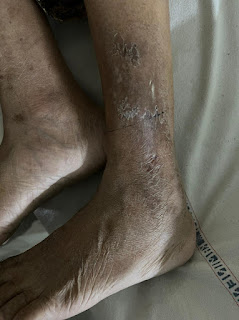MEDICINE BLENDED ASSIGNMENT
INFECTIOUS DISEASE( COVID 19)
MASTER CHART
FIRST CASE
Question 1
Interstitial lung diseases (ILDs) comprise a heterogeneous group of acute and chronic lung diseases that cause progressive scarring of the lung tissue, compromising respiratory function and blood oxygenation. The most common form is the idiopathic pulmonary fibrosis (IPF), which in the vast majority of cases affects the older population, in a progressive fibrosing manner, resulting in severe respiratory failure and death within 3–5 years. In patients with preexisting ILD, COVID-19 infection has led to acute exacerbation of underlying ILD. The criteria for ILD exacerbation include subacute worsening of dyspnea and hypoxemia, new pulmonary infiltrates on imaging, and absence of pulmonary emboli, cardiac failure, and other non-pulmonary causes
Question 2
Steroid therapy in covid affecting rheumatoid arthritis
There would be no worsening in RA as we already use corticosteroids in treatment of RA
study provides all specialists facing the COVID-19 emergency with a very reassuring message about the possibility of suggesting RMDs patients to continue their current therapy with ts/bDMARDs without an increased risk and probably with a milder infection course. Conversely, the use of GC especially a dose > 2.5 mg per day should be cautiously evaluated during the pandemic.
Steroid therapy in covid affecting hypothyroidism
Steroids are used in treatment of hyperthyroidism which can be condition deepening in hypothyroidism
Question 3
Yes compared to patients with no autoimmune disorders this patient may have
Question 4
the role of heparin and low molecular weight (LMW) heparin in this setting has been largely overlooked. the role of heparan sulfate as a key entry mechanism for SARS-CoV-2; the efficacy of heparin and LMW heparin in counteracting its entry into the cell, the recent experimental findings obtained in in vitro studies using the LMW heparin enoxaparin Inhixa®, the role of heparin and LMW heparin in modulating the cytokine storm, and the evidence for the use of LMW heparin in the prevention and treatment of the thromboembolic complications of COVID-19. The available evidence suggests that LMW heparin appears as a promising tool in the treatment of COVID-19. Whether its systematic use is associated with a reduction in complications and ultimately mortality of these patients is being tested in several studies starting worldwide. the virus firstly binds to the abundant HS in the extracellular matrix, increasing its density on the cell surface, and promoting the recognition to its ACE2 receptor. Heparin (100 µg/mL) added 30 min before infection of Vero cells with SARS-CoV reduced the formation of plaques by 50%.the human coronavirus NL63 similar to SARS-CoV-2 S1 RBD undergoes conformational change upon heparin binding, and this decreases the adhesion and hence the interaction with the ACE receptors. Since the interaction with heparan sulfate acts to facilitate ACE receptors binding by virus, it is also possible to block virus cell entry by modulating ACE 2 receptors,
SECOND CASE
Question 1
protein ACE-2 which binds to SARS-Cov-2 and allows the virus to enter human cells is not only located in the lungs, but also in organs and tissues involved in glucose metabolism such as the pancreas, the small intestine, the fat tissue, the liver and the kidney. by entering these tissues, the virus may cause multiple and complex dysfunctions of glucose metabolism. it is possible that the novel coronavirus may alter glucose metabolism that could complicate the condition of preexisting diabetes or lead to new mechanisms of disease.It is said virus infections can also precipitate type 1 diabetes - a chronic condition in which the pancreas produces little or no insulin.
Question 2
Yes, In covid patients with diabetes there is a risk of release of tissue injury-related enzymes, excessive uncontrolled inflammation responses and hypercoagulable state associated with dysregulation of glucose metabolism which can lead to severe pneumonia these patients also show many pathological changes in hrct scan
Question 3
D dimer - Pulmonary embolism and deep vein thrombosis were ruled out in patients with high probability of thrombosis. D-dimer levels significantly increased with increasing severity of COVID-19 as determined by clinical staging (Kendall’s tau-b = 0.374, P = 0.000) and chest CT staging role of D dimer is to determine the severity and reliable prognostic marker for in-hospital mortality in patients admitted for COVID-19.
It should be changing management so that anti coagulants or antiplatelet are given to prevent hemorrhagic/ischemic stroke in the patient
THIRD CASE
Question 1
Noradrenaline (norepinephrine) is very effective in raising arterial blood pressure and, under almost all circumstances, can be titrated to achieve the desired MAP in a given patient. When given in conscious mammals, renal blood flow is increased and renal vascular resistance decreased in response to infusion.it increase organ perfusion and gfr and renal blood flow in this way it helpful to manage both hypotension and acute kidney injury at the same time
Question 2
Blood levels of C-reactive protein (CRP) and lactic dehydrogenase (LDH) at the time of non-ICU admission for COVID-19 predict likelihood of adverse outcomes, including development of more serious illness, increased oxygen requirements or ICU transfer. So finds the first detailed characterization of clinical course among COVID-19 patients admitted to a non-ICU setting outside a COVID-19 epicenter, using a remote central monitoring unit (CMU).
“CRP and LDH blood levels can help stratify risk and prioritize resource allocation for non-ICU patients with COVID-19”
Question 3
Advantages of using mechanical ventilation with intubation over other methods include the humidification of oxygen to prevent dehydration of the airway passages, the high flow rates can be used to provide carbon dioxide ‘washout’, there is a reduction in the anatomical dead space and oxygen levels close to 100% can be delivered.
FOURTH CASE
Question no 1
ESR – erythrocyte sedimentation rate
As it is related to hemoglobin and c reactive protein and c reactive protein increases in covid infection there was increase in ESR



Comments
Post a Comment